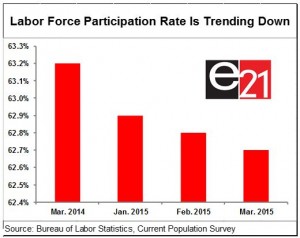Generous Welfare and Increasing Minimum Wage Decrease the Labor Force Participation Rate
< < Go Back
The March jobs numbers were disappointing not only for the lower level of job creation, but for the continued decline in the labor force participation rate. It is now at 62.7 percent. Last year’s average labor force participation rate was 62.9 percent.
Over the past few years, the trend of labor force participation rate has moved in one direction — down — despite steady but slow economic growth over the past few years.
If America had the 2006 labor force participation rates with the same number of people employed, last year’s average unemployment rate would have been 11.4 percent instead of 6.2 percent.
– In 2006, 91 percent of men ages 25 to 54 years old were in the labor force. In 2014 the share was 88 percent. Controlling for demographic shifts, three million fewer men are in the labor force now compared with seven years ago.
– Historically, about 25 percent of women work part time. The share of women ages 25 to 54 years working or looking for work has declined to 74 percent last year from 76 percent in 2006. That adds up to 2.6 million fewer women in the labor force.
– The labor force participation rate for workers ages 20 to 24 years old was 75 percent in 2006 compared with 71 percent last year. That is 800,000 fewer young workers.
– The labor force participation rate for workers ages 16 to 19 years old was 34 percent last year, compared to 44 percent in 2006. Controlling for demographic shifts, that adds up to 400,000 fewer teens.
With broader eligibility for government-provided food stamps, health care, and disability benefits, it has become more advantageous for some people to stay home than to work. At the same time, increases in the minimum wage and burdensome regulations have made it harder for employers to hire more employees.
The solution is to move the provision of welfare benefits back to the states and leave regulations to the states.
More From NCPA:




